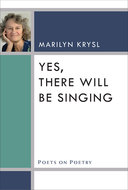 Marilyn Krysl. Yes, There Will Be Singing. University of Michigan Press, 2014. 180 pgs. $27.95.
Marilyn Krysl. Yes, There Will Be Singing. University of Michigan Press, 2014. 180 pgs. $27.95.
Reviewed by Lynn Domina
Nearly twenty years ago when I read Marilyn Krysl’s Warscape with Lovers, already her seventh collection of poetry, I learned something crucial. Krysl is, as anyone who has read much of her work knows, a master of the sestina. It’s a form that’s easy to write very badly and extraordinarily difficult to write at all well. Its six repeated words, the teleutons, can so dominate the writer’s consciousness that the entire rhythm—not only the content—of the poem is controlled by their presence. All movement in the poem is thrust toward them, even if the lines are enjambed and the sentences develop beyond them. Reading Krysl’s sestinas, I noticed a different strategy. In “Nammu: To Adam,” for example, or even moreso in the book’s title poem, “Warscape with Lovers,” Krysl relies on other content to determine the rhythm, lovemaking or an ocean’s waves or fear. The rhythm of the line, therefore, becomes at least as strong as the lexical repetition required by the form, until the repetition recedes from the reader’s ear. Sestinas so often collapse in on themselves—much more often than poems in other forms—but Krysl’s escape this fate because she approaches this potentially heavy-handed form with an extraordinarily light touch. Once I understood why Krysl’s sestinas succeeded so well, I understood form itself much more fully. There are only two or three other contemporary poets whose work has taught me so much.
So I was very glad to be able to read Yes, There Will Be Singing, a collection of Krysl’s essays. Three of the essays focus on the sestina specifically, and another explores the litany, whose core definition is also repetition. In these essays, Krysl analyzes several examples that work differently from each other, and she discusses the attraction of repetition generally, along with the necessity of variation. I particularly appreciated her engagement with James Cummins’ “Tiresias”—which uses “father,” “woman,” “man,” “mother,” and “face” (used twice) as its teleutons—and Patricia Smith’s sestina about Stevie Wonder, “Looking to See How the Eyes Inhabit Dark, Wondering about Light”—which uses light,” “wonders,” “dark,” “eyes,” “see,” and “look” as its teleutons. These two poets had clearly set themselves a challenge, and Krysl’s explanations of their strategies are both insightful and useful. Through her close analysis of craft, Krysl shows the reader not only how these particular poems were written, but also how more poems might be written. Patient with the work, she is an attentive teacher.
This section on the sestina follows the opening section of the collection, containing five essays that are predominantly autobiographical. Their focus is language and how Krysl came to appreciate it as a way of making and revealing meaning as well as a source of musical pleasure. Three additional sections follow those on the sestina and litany: “Illustrious Forebears,” “Poetry as a Way of Witnessing,” and “Poetry and the Healing Arts.” The essays in the first two focus on individual poets, including Marianne Moore, Anna Akhmatova, W.S. Merwin, Ingrid Wendt, and others. The final section returns to Krysl’s own work, describing the relationship between her writing and her experiences caring for the destitute. As a whole, then, this book illustrates the integration of the work and the life.
As a working poet, I most appreciate the poet-critic who can comment on the content and context of a poet’s work as well as evaluate the craft, analyzing the poet’s strategies with language. When I am particularly affected by a poem, I want the critic to answer my astonished question: “How did she do that?” Through her experience in the world and her thoughtfulness about poetry, Krysl guides the reader through several poems by positioning the poems within their context and by describing how context and craft interact. In her chapter on Ingrid Wendt, for example, she discusses William Stafford’s influence on Wendt, focusing particularly on their mutual commitment to nonviolence and to their concern for environmental sustainability. Analyzing Wendt’s poem “Endangered Species,” Krysl attends to the poem’s grammar, its sentences and lines, to show how she succeeds artistically while simultaneously engaging the world as a responsible citizen: “the poem ‘Endangered Species’ is much more than an evocative description of wild turkeys. ‘Endangered Species’ is a political term which highlights the fact that the violence of species depletion is violence visible only in statistics. Wendt highlights the extremity of species’ deaths by a cunning use of the words ‘if’ and ‘as if’—‘if’ through the body of the poem, ‘as if’ at the poem’s conclusion. Notice how ‘if’ builds a chain of linked contingencies…” The poem Krysl cites is evocative, and it is not trite. Her discussion demonstrates how through attention to craft, poetry can be made more rather than less relevant to significant cultural issues.
Yes, There Will Be Singing consists of highly interesting essays, and so in that sense it feels like a quick read. The essays are also often meditative and thought-inspiriting, so in that sense it also feels like a contemplative read. It is a book that speaks to our time. Given the unfortunate complexity of the interrelated problems—war, poverty, environmental destruction, hunger—that are ours to solve, I imagine it will remain relevant for quite a while. Fortunately, the quality of the writing will make it a congenial companion as we discern our responses.
